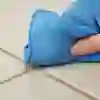Share:
Grouting bathroom tiles is a crucial step that ensures your tiles are not only aesthetically pleasing but also protected long-term from moisture. By following these helpful steps and tips, you can achieve a professional and long-lasting grout finish for your bathroom tiles through a DIY project.

Tools You'll Need:
- Grout: Choose the right type for your bathroom (cement-based, epoxy, or ready-mixed) For wet areas like showers, a waterproof grout or a good sealer is essential.
- Mixing Bucket: For powdered grout.
- Mixing Implement: A margin trowel, paint stirrer stick, or a drill with a paddle mixer attachment.
- Grout Float: A rubber-based tool for spreading grout.
- Grouting Sponge: A dense, absorbent sponge for cleaning.
- Clean Water Buckets: Have at least two, one for initial rinsing and one for final cleaning. Change water frequently.
- Microfibre Cloths: For buffing and removing haze.
- Rubber Gloves: To protect your hands.
- Safety Glasses: To protect your eyes.
- Face Mask: Especially when mixing powdered grout to avoid inhaling dust.
- Grout Sealer (optional but recommended): For cement-based grouts, to protect against moisture and staining.
- Grout Finishing Tool (optional): For shaping grout lines.
Step-by-Step Guide:
1. Preparation is Key:
- Curing Time: Ensure your tile adhesive has fully cured. This typically takes 24-72 hours, but always check the adhesive manufacturer's instructions. Grouting too early can lead to discolouration and weaken the grout.
- Clean Joints: Remove all tile spacers, debris, dust, and excess adhesive from the grout lines. A clean surface ensures proper grout adhesion. You can use a utility knife or scraper for stubborn bits.
- Protect Surfaces: Lay down dust sheets to protect your flooring, fixtures, and furniture from grout spills.
- Trial Run (for porous tiles): If you have porous tiles (e.g. some natural stone), apply a small amount of grout to an offcut or inconspicuous area to check for staining or difficulty in cleaning off excess. You might need to apply a protective sealer to the tiles before grouting.
- Dampen Joints (in hot weather): If working in temperatures above 25°C or with porous tiles, lightly dampen the grout joints with clean water to prevent the grout from drying too quickly.

2. Mix the Grout:
Read Instructions: Always follow the manufacturer's instructions for your specific grout.
Add Water First: For powdered grout, pour the recommended amount of clean water into your mixing bucket first, then gradually add the grout powder.
Mix Thoroughly: Stir until you achieve a smooth, lump-free, paste-like consistency. Avoid over-mixing, as this can introduce air bubbles.
Slake Time: Many cement-based grouts require a "slake" time (usually 5-10 minutes) after initial mixing. Let it sit, then remix before applying. This allows the polymers to activate and prevents weakness or cracking.
Work in Batches: Only mix as much grout as you can use within 20-30 minutes, as it will start to harden.

3. Apply the Grout:
Scoop Grout: Scoop a generous amount of grout onto your grout float.
Spread Diagonally: Hold the grout float at a 45-degree angle to the tiled surface and spread the grout firmly across the tiles, working it into the joints.
Fill Completely: Ensure all gaps are completely filled with grout, pressing hard enough to avoid air pockets but not so hard that the grout bulges excessively.
Work Methodically: Work in manageable sections (e.g. 10 square feet at a time) to ensure the grout doesn't dry before you can clean it.
Scrape Excess: Use the edge of the float to scrape off as much excess grout from the tile faces as possible and work it into the next section.

4. Remove Excess Grout (Initial Clean):
Wait for Initial Set: Allow the grout to set slightly. This usually takes 15-30 minutes, depending on the grout type and environmental conditions. The grout should be firm to the touch but still damp enough to leave a slight impression when pressed.
Damp Sponge: Dampen your grouting sponge (don't let it drip) and gently wipe across the tiled surface in a diagonal direction. The goal is to remove most of the excess grout from the tile faces without disturbing the freshly filled grout lines.
Rinse Frequently: Rinse your sponge in clean water very frequently to avoid smearing grout back onto the tiles. Use a separate bucket for this initial rinse water. Don't over-wet the grout lines, as this can weaken the grout or cause discolouration.
5. Smooth the Grout Lines:
Smooth and Even: With a clean, damp sponge, run it gently along the grout lines to smooth them out and create a uniform finish. You can use your index finger to apply gentle pressure if needed.
Grout Finishing Tool (optional): For perfectly consistent lines, you can use a grout finishing tool, pulling its rounded end evenly over the joints.

6. Clean Off Grout Haze (Final Clean):
Wait for Further Set: After smoothing the lines, wait another 30-60 minutes to allow the grout to harden further.
Damp Sponge Wipe: Dampen a clean sponge and gently wipe the tile surface again, working diagonally, to remove the powdery grout haze. Rinse and wring out your sponge often.
Microfibre Buff: For the final clean, use two microfibre cloths: one damp to remove any remaining haze, and then a dry one to buff the tiles to a shine. Be very gentle at this stage to avoid disturbing the grout.
7. Cure and Seal:
Curing Time: Allow the grout to cure according to the manufacturer's instructions fully. This typically takes 24-72 hours before walking on it or exposing it to moisture. For showers, it's often recommended to wait a minimum of 7-14 days before using.
Apply Sealer (if needed): If you've used a cement-based grout, apply a grout sealer once the grout is fully cured. This will protect it from moisture, and stains, and make it easier to clean. Follow the sealer's instructions for application and curing time.
FAQs When Grouting Bathroom Tiles
Do I Really Need to Grout Between Tiles?
Yes! Grout is essential. It secures the tiles in place, prevents them from shifting or cracking, and acts as a crucial barrier against moisture, dirt, and debris from seeping underneath, especially in wet areas like bathrooms.
What Type of Grout Should I Use for a Bathroom?
Cement-based grout: Most common and affordable, good for general use. For bathrooms, choose a polymer-modified version for improved water resistance, or apply a good sealer.
Epoxy grout: Highly durable, stain-resistant, and completely waterproof. Ideal for wet rooms, showers, or high-traffic areas, but can be more challenging to work with and more expensive.
Ready-mixed grout: Convenient for smaller jobs or splashbacks, but often not suitable for large areas or constantly wet environments like showers due to faster drying times on the tile surface.
How Long Should I Wait After Tiling Before Grouting?
You must wait until the tile adhesive has completely cured. This can range from 24 to 72 hours, but always check the specific adhesive manufacturer's instructions. Grouting too soon can lead to discolouration of the grout or weak bonds.
What’s the Best Way to Choose Grout Colour?
Matching: A grout colour that closely matches your tiles creates a seamless, uniform look, making the tiles themselves the focal point. This can also make a small room appear larger.
Contrasting: A contrasting grout colour (e.g. dark grout with light tiles) can highlight the tile pattern and shape, adding character and visual interest.
Practicality: In high-traffic or potentially dirtier areas, a darker grout may be more forgiving and show less grime.
Can I Grout over the Existing Grout?
No, it's generally not recommended. New grout will not properly adhere to old grout and is likely to flake or chip. For a lasting finish, remove the old grout (to at least half the thickness of the tile) using a grout saw or oscillating tool before applying the new grout.
How Long Does Grout Take to Dry?
Grout typically takes 24 to 72 hours to fully cure, depending on the type of grout, temperature, humidity, and ventilation. Always refer to the manufacturer's instructions. Avoid walking on newly grouted floors or exposing wet areas to water during this time.
My Grout Looks Patchy or Discolored. What Happened?
Patchiness or discolouration can occur due to:
Over-watering: Using too much water when mixing the grout or when cleaning can weaken the grout and wash out pigment.
Cleaning too early/late: Wiping too soon can pull out pigment while waiting too long can make it difficult to remove the haze evenly.
Inconsistent mixing: Not mixing the grout thoroughly or consistently can lead to variations.
Adhesive still wet: Grouting over uncured adhesive can cause moisture to evaporate through the grout, leading to spots.
How Do I Clean Grout Haze That Won’t Come Off?
If a stubborn haze remains after the grout has cured, you can use a specialised grout haze remover, following the product's instructions carefully.
By following our helpful guide, you can grout your bathroom tiles with ease and promote a healthier, fresher, and good-looking space that everyone in the home can benefit from. Be sure to check out our Help & Advice section for further help and guidance on tackling common DIY bathroom jobs.
